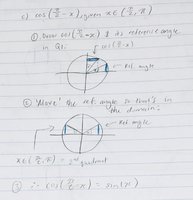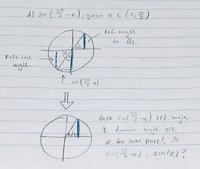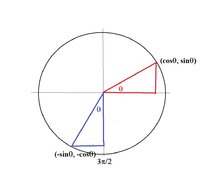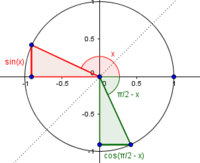I am SO confused on how to do (d) - please refer to the attachments.
I asked my maths teacher today how to do all of question 15 because I did not understand why the domain was even needed to answer the question - I had just used the angle given in the question and then sketched the reference angle and got all of the answers correct, however I know how I did it is wrong because you must consider the 'x' domain angle in order to answer the question apparently.
The issue is, my teacher explained to me that to answer the questions, you draw the given angle, then sketch the reference angle into quadrant 1 (Q1), then reflect/translate the same angle into whatever quadrant 'x' is supposed to be in, in reference to the given domain. Attachment T shows what my teacher told me to do in order to answer the questions - I used (c) as a main example. This worked for (a), (b), and (c), however it does NOT work for (d). I have no idea why, I am just so confused and have been stuck on this question for like 2 weeks... I asked my teacher again later today about why it does not work for (d) but we did not have time to discuss it so I am still completely stuck...
Thank you!
I asked my maths teacher today how to do all of question 15 because I did not understand why the domain was even needed to answer the question - I had just used the angle given in the question and then sketched the reference angle and got all of the answers correct, however I know how I did it is wrong because you must consider the 'x' domain angle in order to answer the question apparently.
The issue is, my teacher explained to me that to answer the questions, you draw the given angle, then sketch the reference angle into quadrant 1 (Q1), then reflect/translate the same angle into whatever quadrant 'x' is supposed to be in, in reference to the given domain. Attachment T shows what my teacher told me to do in order to answer the questions - I used (c) as a main example. This worked for (a), (b), and (c), however it does NOT work for (d). I have no idea why, I am just so confused and have been stuck on this question for like 2 weeks... I asked my teacher again later today about why it does not work for (d) but we did not have time to discuss it so I am still completely stuck...
Thank you!




